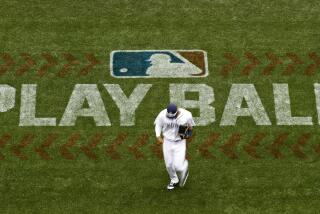Jim Bouton’s bawdy ‘Ball Four’ transformed baseball’s public image
With the death Wednesday of Jim Bouton, here are the Great Scorekeeper’s figures for the big right-hander: Lifetime pitching record of 62-63. Earned-run average of 3.57. Pitched 1,238.2 innings. Blazed 720 strikeouts in a career spent with the New York Yankees, Houston Astros, Atlanta Braves and the ill-fated Seattle Pilots. A World Series record of 2-1.
All that plus the figure for which he is destined to be best remembered: ISBN 0-02-030665-2.
That international book code reminds us that while some pitchers are honored for the artistry of their fastball (Walter Johnson, Nolan Ryan), or of their curveball (Sandy Koufax, Clayton Kershaw), or of their knuckleball (Phil Niekro, Hoyt Wilhelm), Bouton — an old knuckleball hurler himself — is remembered for the artistry of the greatest changeup ever written: a book that transformed the public view of baseball and the entire genre of the literature of sports.
Book lovers! Sign up for the new L.A. Times Book Club for upcoming author events »
“Ball Four” is a Hall of Fame book, and the phrase that was employed to disparage it — “detrimental to baseball,” proclaimed by baseball commissioner Bowie Kuhn — was as much a lure to readers as the label “Banned in Boston” (often attributed to the 19th century moral crusader Anthony Comstock) that was famously applied in 1935 to Clifford Odets’ “Waiting for Lefty,” which was not about Warren Spahn or Steve Carlton or even Hyun-Jin Ryu.
For 50 years readers have flocked to the booksellers for the volume and devoured it. Many fans can recite full passages by heart a half-century later, especially the dirty parts.
“Ball Four” may not have been the best baseball book ever — we can spark a debate on that, and among the many contenders are Roger Kahn’s “The Boys of Summer” and Lawrence S. Ritter’s “The Glory of Their Times.” But “Ball Four” was surely the best sports book ever written by a player; only “The Game,” by hockey goalie Ken Dryden, comes close.
But its real significance is that it arguably is the most influential sports book ever.
Its impact was as much in what it did (open the clubhouse door to what really went on in the lives of ballplayers) as in what it said (which was outrageous, sometimes tawdry, occasionally salacious, ultimately unforgettable).
Once “Ball Four” hit the shelves, the establishment of America’s signature game was, in the special argot of baseball, HBP (the scorecard abbreviation for “hit by pitcher”). The paladins of baseball were infuriated. Parents were scandalized. With this book, the finger that Bouton left out of his glove, as ballplayers have done for generations, was not his index finger.
‘The Great American Sports Page’ is the greatest hits of sports journalism »
The game no longer was merely a country idyll, a metaphor for the American character, an expression of geometric perfection, a Norman Rockwell cover in the Saturday Evening Post, a nostalgia-tinged image of boys and fathers playing catch across the generations: the well-loved literary pablum of the game. Instead it was glorious but grimy, captivating but controversial, irresistible but just short of unredeemable.
While the ballplayers in Bouton’s book weren’t the clean-cut heroes of folklore, they weren’t quite Roy Hobbs of “The Natural” either. They were slightly lovable, slightly loutish. They were boozers and womanizers, serial offenders of the values of the middle class that paid their salaries, which were lavish for the times but exceedingly modest by our standards. This was, to be sure, before the #MeToo movement, but even by 1970s standards these bad boys were, in a phrase, bad boys.
Bouton’s book was rooted in 1969, a year of transition — the moon landing changed our view of humankind’s place in the cosmos forever, the accident at Chappaquiddick changed Sen. Edward M. Kennedy’s political prospects forever, Woodstock changed rock music’s profile forever. It is not too much to say that “Ball Four” changed sports, and the literature of sports, forever. The heroes were less heroic; the role models modeled behavior that no parent or preacher embraced; the authority figures lacked authority, especially in the eyes of the pitcher-author.
A principal victim: the once-magical memory of Mickey Mantle.
Earlier in the 1960s he was the clean-cut hero of the Yankees, twinned in 1961 with Roger Maris in a home-run battle for the ages. Now he was a boozer and a lech. Mantle still has a lifetime .298 batting average, but Bouton besmirched Mantle’s image forever, and Peter Golenbock, in “Seven,” and Jane Leavy, in “The Last Boy,” were not exactly cleanup hitters. Instead, they were closers on Mantle’s reputation. But Bouton was the setup man.
If the poet/singer Leonard Cohen was right in saying “there is a crack in everything, that’s how the light gets in,” then Bouton cracked open baseball, and the light that got in revealed a steamy, seamy reality. The ballplayers took drugs, pitchers scuffed the ball, outfielders peered lasciviously at women in the bleachers. New York Daily News columnist Dick Young may have dismissed Bouton as a ‘’social leper” — he was not alone in deploring the book — but the criticism never troubled him. And, unlike the Seattle Pilots, who disappeared after a single season and moved to become the Milwaukee Brewers, Jim Bouton has never been forgotten.
Shribman, a Pulitzer Prize winner who for 16 years was executive editor of the Pittsburgh Post-Gazette.
More to Read
Sign up for our Book Club newsletter
Get the latest news, events and more from the Los Angeles Times Book Club, and help us get L.A. reading and talking.
You may occasionally receive promotional content from the Los Angeles Times.






